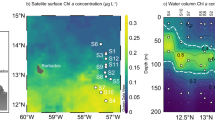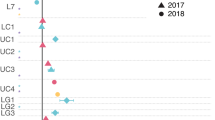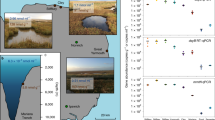Abstract
Biogenic methane is widely thought to be a product of archaeal methanogenesis, an anaerobic process that is inhibited or outcompeted by the presence of oxygen and sulfate1,2,3. Yet a large fraction of marine methane delivered to the atmosphere is produced in high-sulfate, fully oxygenated surface waters that have methane concentrations above atmospheric equilibrium values, an unexplained phenomenon referred to as the marine methane paradox4,5. Here we use nuclear magnetic resonance spectroscopy to show that polysaccharide esters of three phosphonic acids are important constituents of dissolved organic matter in seawater from the North Pacific. In seawater and pure culture incubations, bacterial degradation of these dissolved organic matter phosphonates in the presence of oxygen releases methane, ethylene and propylene gas. Moreover, we found that in mutants of a methane-producing marine bacterium, Pseudomonas stutzeri, disrupted in the C–P lyase phosphonate degradation pathway, methanogenesis was also disabled, indicating that the C–P lyase pathway can catalyse methane production from marine dissolved organic matter. Finally, the carbon stable isotope ratio of methane emitted during our incubations agrees well with anomalous isotopic characteristics of seawater methane. We estimate that daily cycling of only about 0.25% of the organic matter phosphonate inventory would support the entire atmospheric methane flux at our study site. We conclude that aerobic bacterial degradation of phosphonate esters in dissolved organic matter may explain the marine methane paradox.
This is a preview of subscription content, access via your institution
Access options
Subscribe to this journal
Receive 12 print issues and online access
$259.00 per year
only $21.58 per issue
Buy this article
- Purchase on Springer Link
- Instant access to full article PDF
Prices may be subject to local taxes which are calculated during checkout



Similar content being viewed by others
References
Thauer, R. K., Kaster, A.-K., Seedorf, H., Buckel, W. & Reiner, H. Methanogenic archaea: ecologically relevant differences in energy conservation. Nat. Rev. Microbiol. 6, 579–591 (2008).
Garcia, J.-L., Patel, B. K. & Ollivier, B. Taxonomic, phylogenetic and ecological diversity of methanogenic archaea. Anaerobe 6, 205–226 (2000).
Liu, Y. & Whitman, W. B. Metabolic, phylogenetic, and ecological diversity of the methanogenic archaea. Ann. NY Acad. Sci. 1125, 171–189 (2000).
Reeburgh, W. S. Oceanic methane biogeochemistry. Chem. Rev. 107, 486–513 (2007).
Kiene, R. P. Microbial Production and Consumption of Greenhouse Gases: Methane, Nitrogen Oxides, and Halomethanes (ASM, 1991).
Oremland, R. S. Methanogenic activity in plankton samples and fish intestines: a mechanism for in situ methanogenesis in oceanic surface waters. Limnol. Oceanogr. 24, 1136–1141 (1979).
De Angelis, M. A. & Lee, C. Methane production during zooplankton grazing on marine phytoplankton. Limnol. Oceanogr. 39, 1298–1308 (1994).
Ditchfield, A. K. et al. Identification of putative methylotrophic and hydrogenotrophic methanogens within sedimenting material and copepod faecal pellets. Aquat. Microbiol. Ecol. 67, 151–160 (2012).
Ploug, H., Kuhl, M., Buchholz-Cleven, B. & Jorgensen, B. B. Anoxic aggregates-an ephemeral phenomenon in the pelagic environment? Aquat. Microbiol. Ecol. 13, 285–294 (1997).
Simon, M., Grossart, H., Schweitzer, B. & Ploug, H. Microbial ecology of organic aggregates in aquatic ecosystems. Aquat. Microbiol. Ecol. 28, 175–211 (2002).
Cook, A. M., Daughton, C. G. & Alexander, M. Phosphonate utilization by bacteria. J. Bacteriol. 133, 85–90 (1978).
Kamat, S. S., Williams, H. J., Dangott, L. J., Chakrabarti, M. & Raushel, F. M. The catalytic mechanism for aerobic formation of methane by bacteria. Nature 497, 132–136 (2013).
Karl, D. M. et al. Aerobic production of methane in the sea. Nat. Geosci. 1, 473–478 (2008).
Metcalf, W. W. et al. Synthesis of methylphosphonic acid by marine microbes: a source for methane in the aerobic ocean. Science 337, 1104–1107 (2012).
Yu, X. et al. Diversity and abundance of phosphonate biosynthetic genes in nature. Proc. Natl Acad. Sci. USA 110, 20759–20764 (2013).
Kolowith, L. C., Ingall, E. D. & Benner, R. Composition and cycling of marine organic phosphorus. Limnol. Oceanogr. 46, 309–320 (2001).
Sannigrahi, P., Ingall, E. D. & Benner, R. Cycling of dissolved and particulate organic matter at station ALOHA: insights from 13C NMR spectroscopy coupled with elemental, isotopic and molecular analyses. Deep-Sea Res. I 52, 1429–1444 (2005).
Karner, M. B., DeLong, E. F. & Karl, D. M. Archaeal dominance in the mesopelagic zone of the Pacific Ocean. Nature 409, 507–510 (2001).
Santoro, A. E. et al. Genomic and proteomic characterization of “Candidatus Nitrosopelagicus brevis”: an ammonia-oxidizing archaeon from the open ocean. Proc. Natl Acad. Sci. USA 112, 1173–1178 (2015).
del Valle, D. & Karl, D. M. Aerobic production of methane from dissolved water column methylphosphonate and sinking particles in the North Pacific Subtropical Gyre. Aquat. Microbiol. Ecol. 73, 93–105 (2014).
Young, C. L. & Ingall, E. D. Marine dissolved organic phosphorus composition: insights from samples recovered using combined electrodialysis/reverse osmosis. Aquat. Geochem. 16, 563–574 (2010).
Aluwihare, L. I., Repeta, D. J. & Chen, R. F. A major biopolymeric component to dissolved organic carbon in surface sea water. Nature 387, 166–169 (1997).
McGrath, J. W., Chin, J. P. & Quinn, J. P. Organophosphonates revealed: new insights into the microbial metabolism of ancient molecules. Nat. Rev. Microbiol. 11, 412–419 (2013).
Holmes, E. M., Sansone, J. F., Rust, T. M. & Popp, B. N. Methane production, consumption, and air-sea exchange in the open ocean: an evaluation based on carbon isotopic ratios. Glob. Biogeochem. Cycles 14, 1–10 (2000).
Sasakawa, M. et al. Carbon isotopic characterization for the origin of excess methane in subsurface seawater. J. Geophys. Res. 113, C03012 (2008).
Repeta, D. J. & Aluwihare, L. I. Radiocarbon analysis of neutral sugars in high molecular weight dissolved organic carbon: implications for organic carbon cycling. Limnol. Oceanogr. 51, 1045–1053 (2006).
Björkman, K. & Karl, D. M. Bioavailability of dissolved organic phosphorus in the euphotic zone at Station ALOHA, North Pacific Subtropical Gyre. Limnol. Oceanogr. 48, 1049–1057 (2003).
van Mooy, B. A. S. et al. Major role of planktonic phosphate reduction in the marine phosphorus redox cycle. Science 348, 783–785 (2015).
Bogard, M. J. et al. Oxic water column methanogenesis as a major component of aquatic CH4 fluxes. Nat. Commun. 5, 5350 (2014).
Martinez, A., Tyson, G. W. & Delong, E. F. Widespread known and novel phosphonate utilization pathways in marine bacteria revealed by functional screening and metagenomic analyses. Environ. Microbiol. 12, 222–238 (2010).
Karl, D. K. & Tien, G. MAGIC: a sensitive and precise method for measuring phosphorus in aquatic environments. Limnol. Oceanogr. 37, 105–116 (1992).
Repeta, D. J. in Biogeochemistry of Dissolved Organic Matter (eds Hansell, D. A. & Carlson, C. A.) 21–63 (Academic, 2015).
Ferrón, S., Wilson, S. T., Martínez-García, S., Quay, P. D. & Karl, D. M. Metabolic balance in the mixed layer of the oligotrophic North Pacific Ocean from diel changes in O2/Ar saturation ratios. Geophys. Res. Lett. 42, 3421–3430 (2015).
Kana, T. M. et al. Membrane inlet mass spectrometer for rapid high-precision determination of N2, O2, and Ar in environmental water samples. Anal. Chem. 66, 4166–4170 (1994).
Kana, T. M., Cornwell, J. C. & Zhong, L. Determination of denitrification in the Chesapeake Bay from measurements of N2 accumulation in bottom water. Estuar. Coast 29, 222–231 (2006).
García, H. E. & Gordon, L. I. Oxygen solubility in seawater: better fitting equations. Limnol. Oceanogr. 37, 1307–1312 (1992).
Hamme, R. C. & Emerson, S. R. The solubility of neon, nitrogen and argon in distilled water and seawater. Deep-Sea Res. I 51, 1517–1528 (2004).
Sosa, O. A., Gifford, S. M., Repeta, D. J. & DeLong, E. F. High molecular weight dissolved organic matter enrichment selects for methylotrophs in dilution to extinction cultures. ISME J. 9, 1–15 (2015).
Lalucat, J., Bennasar, A., Bosch, R., García-Valdés, E. & Palleroni, N. J. Biology of Pseudomonas stutzeri. Microbiol. Mol. Biol. Rev. 70, 510–547 (2006).
White, A. K. & Metcalf, W. W. Two C–P lyase operons in Pseudomonas stutzeri and their roles in the oxidation of phosphonates, phosphite, and hypophosphite. J. Bacteriol. 186, 4730–4739 (2004).
Errey, J. C. & Blanchard, J. S. Functional annotation and kinetic characterization of PhnO from Salmonella enterica. Biochemistry 45, 3033–3039 (2006).
Hover-Jensen, B., McSorley, F. R. & Zechel, D. L. Catabolism and detoxification of 1-aminoalkylphosphonic acids: N-acetylation by the phnO gene product. PLoS ONE 7, e46416 (2012).
Metcalf, W. W. & Wanner, B. L. Mutation analysis of an Escherichia coli fourteen-gene operon for phosphonate degradation, using TnphoA′ elements. J. Bacteriol. 175, 3430–3442 (1993).
Acknowledgements
We thank the Captain and crew of the RV Kilo Moana as well as K. Olson and the staff at the Natural Energy Laboratory, Hawaii Authority for assistance in sample collection. We also thank R. Boiteau for his assistance with mass spectrometry, A. Bate for helping with gas chromatography measurements, K. Doggett for flow cytometry analysis and the Hawaii Ocean Time-series team for facilitating part of this work. This research is a contribution of the Daniel K. Inouye Center for Microbial Oceanography: Research and Education (C-MORE) and was supported by the Gordon and Betty Moore Foundation (through Grants GBMF3298 to D.J.R. and E.F.D., GBMF3777 to E.F.D. and GBMF3794 to D.M.K.), as well as a grant from the Simons Foundation (SCOPE Award ID 329108 to D.J.R., E.F.D. and D.M.K.).
Author information
Authors and Affiliations
Contributions
D.M.K., D.J.R. and E.F.D. designed the experiments with input from all co-authors. D.J.R. collected and purified DOM samples, and performed spectral analyses. S.F. performed microcosm incubations and trace gas analyses with input from D.M.K. O.A.S. isolated DOM degrading microbes, performed genomic analyses, and performed microcosm incubations and trace gas analyses with input from E.F.D. C.G.J. performed NMR spectral analyses of DOM. L.D.R. performed chemical degradation experiments and identified phosphonates in DOM. M.A. purified DOM and assisted in microcosm incubation experiments. D.J.R. drafted the manuscript with input from all authors.
Corresponding author
Ethics declarations
Competing interests
The authors declare no competing financial interests.
Supplementary information
Supplementary Information
Supplementary Information (PDF 1240 kb)
Rights and permissions
About this article
Cite this article
Repeta, D., Ferrón, S., Sosa, O. et al. Marine methane paradox explained by bacterial degradation of dissolved organic matter. Nature Geosci 9, 884–887 (2016). https://doi.org/10.1038/ngeo2837
Received:
Accepted:
Published:
Issue Date:
DOI: https://doi.org/10.1038/ngeo2837
This article is cited by
-
Phosphonate consumers potentially contributing to methane production in Brazilian soda lakes
Extremophiles (2024)
-
Bacterial aerobic methane cycling by the marine sponge-associated microbiome
Microbiome (2023)
-
The facilitating role of phycospheric heterotrophic bacteria in cyanobacterial phosphonate availability and Microcystis bloom maintenance
Microbiome (2023)
-
Widespread natural methane and oil leakage from sub-marine Arctic reservoirs
Nature Communications (2023)
-
Methylphosphonate-driven methane formation and its link to primary production in the oligotrophic North Atlantic
Nature Communications (2023)



